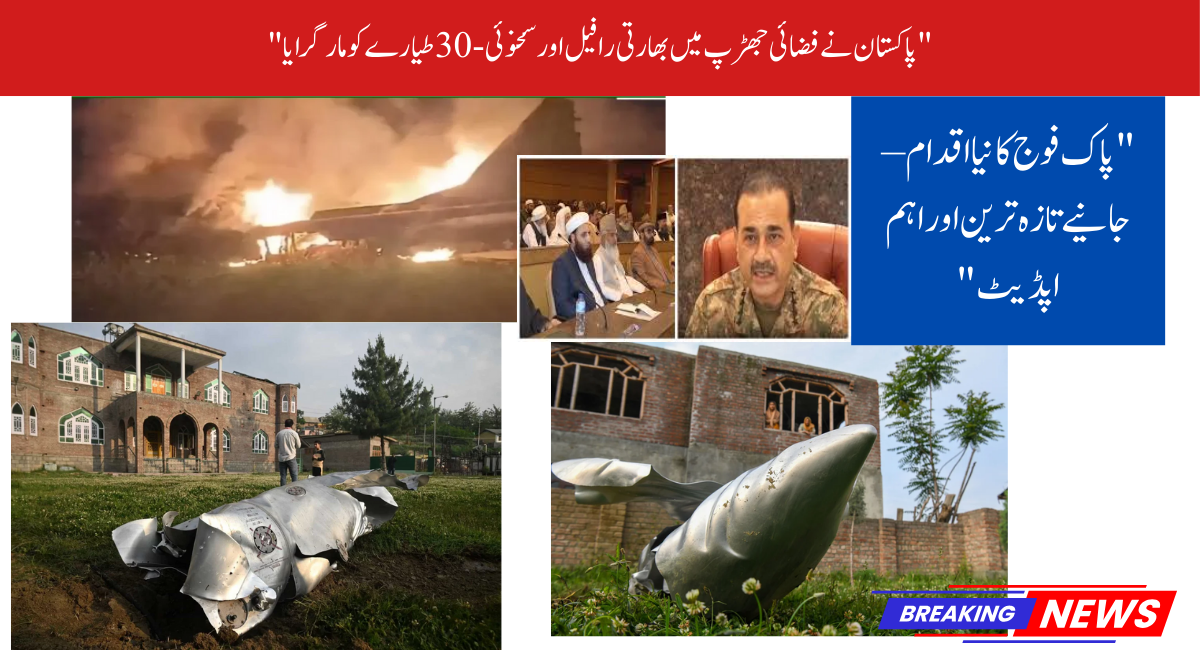Introduction
On May 7, 2025, a significant escalation occurred between India and Pakistan, two nuclear-armed neighbors with a long history of conflict. Pakistan’s military reported shooting down two Indian fighter jets—a Rafale and a Sukhoi-30—during a confrontation near the Line of Control (LoC) in Kashmir. This incident has drawn global attention, raising concerns about the potential for further military escalation in the region.
Background: Rising Tensions
The Pahalgam Attack
The immediate backdrop to this confrontation was the deadly terrorist attack in Pahalgam, Indian-administered Kashmir, on April 22, 2025. The attack resulted in the deaths of 26 individuals, primarily Indian tourists. India accused Pakistan-based militant groups of orchestrating the assault, a claim that Pakistan vehemently denied. In retaliation, India launched “Operation Sindoor” on May 7, 2025, targeting alleged terrorist camps in Pakistan-administered Kashmir. These strikes led to significant civilian casualties in Pakistan, further inflaming hostilities.
The May 7 Air Clash
Pakistan’s Claims
According to Pakistan’s military, the confrontation began when Indian fighter jets violated Pakistani airspace near the LoC. In response, Pakistan’s Air Force engaged the intruding aircraft, resulting in the downing of two Indian jets—a Rafale and a Sukhoi-30. Pakistan also claimed to have destroyed an Indian brigade headquarters and multiple checkposts in the region.
India’s Response
India has denied these claims, stating that no Indian aircraft were lost during the incident. The Indian government maintains that its military operations were conducted within Indian territory and were aimed at neutralizing terrorist threats. India has also accused Pakistan of exaggerating the scale of the confrontation for propaganda purposes.
Read Also: Complete Guide to Ehsaas Program 8171 May 2025: Eligibility & Payment Information
Aircraft Profiles
Indian Rafale
The Dassault Rafale is a French-made multirole fighter jet known for its advanced avionics, stealth capabilities, and versatility in various combat scenarios. It is equipped with long-range missiles like the Meteor, enhancing its air superiority. The Rafale is a cornerstone of India’s air defense strategy.
Indian Sukhoi-30MKI
The Sukhoi-30MKI is a Russian-origin, multirole air superiority fighter developed for the Indian Air Force. It boasts exceptional maneuverability and is capable of carrying a wide array of air-to-air and air-to-ground weapons, including the BrahMos missile. Its advanced radar systems make it a formidable opponent in aerial combat.
Pakistan’s Air Capabilities
Pakistan’s Air Force operates a mix of Chinese-made J-10C fighters and U.S.-made F-16s. These aircraft are equipped with modern avionics and weaponry, including long-range missiles like the PL-15. Pakistan has also invested in electronic warfare technologies to counter advanced enemy systems.
Technical Aspects of the Engagement
Combat Scenario
The engagement reportedly occurred at high altitudes near the LoC, where both air forces have a history of skirmishes. Pakistan’s military claims that its aircraft employed advanced radar-jamming techniques to neutralize the Indian jets’ targeting systems. The use of long-range missiles, such as the PL-15, is also speculated to have played a role in the downing of the aircraft.
Radar and Jamming Technology
Electronic warfare capabilities are crucial in modern aerial combat. Pakistan’s reported use of radar-jamming technology suggests an effort to disrupt the targeting systems of the Indian jets, potentially leading to their downing. However, without official confirmation, these details remain speculative.
Weaponry Used
The specific missiles and countermeasures employed during the engagement have not been officially disclosed. However, the use of advanced air-to-air missiles, such as the PL-15, is likely, given their integration into Pakistan’s fighter aircraft. These missiles offer extended range and enhanced accuracy, making them effective in high-speed aerial combat.
Media Coverage and Public Perception
Social Media Influence
Platforms like X (formerly Twitter) have played a significant role in disseminating information about the incident. Posts claiming the downing of Indian jets have gone viral, contributing to heightened tensions. However, the spread of unverified information has also led to confusion and misinformation.
Misinformation Challenges
The rapid dissemination of unverified claims has made it challenging to ascertain the truth. Fact-checking organizations have struggled to keep up with the volume of information, leading to widespread misinformation. This underscores the need for caution when consuming information from unverified sources.
Role of Traditional Media
Mainstream media outlets have reported on the incident, but the lack of official confirmation from both governments has left many details unclear. The reliance on social media for information has further complicated the situation, highlighting the need for responsible journalism and media literacy.
International Reactions
Global Powers’ Responses
The United States, China, Russia, and the United Nations have expressed concern over the escalating tensions between India and Pakistan. Calls for restraint and dialogue have been issued to prevent further escalation. The international community emphasizes the importance of diplomatic efforts to resolve the crisis.
Diplomatic Efforts
Diplomatic channels are reportedly open, with international mediators engaging both nations
